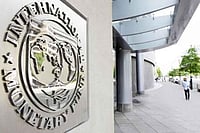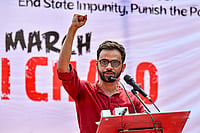When the July 18, 2005, joint statement between India and the United States covering the nuclear deal was signed, there was considerable euphoria over the implicit formal recognition of India's nuclear weapons status and a possible opening up of opportunities for it to become a global player in nuclear energy. The wordings in the statement were straight and clear: India with its strong commitment to preventing WMD proliferation, and as a responsible state with advanced nuclear technology, should acquire the same benefits and advantages, reciprocally assuming the same responsibilities and practices as other leading nations with advanced nuclear technology such as the US. Prime Minister Manmohan Singh reiterated this to Parliament in his statement on July 29, 2005. But seeing the trend of negotiations, this seems to be only on paper.
While the joint statement elaborates on what these responsibilities and practices should be and the actions to be taken by both sides, the ongoing bilateral discussions seem to have run into rough weather over identifying civil and military facilities, with the US now stipulating that the separation should be credible, transparent and defensible; and that the civil list should be long. In particular, the Indian proposal to exclude fast breeder reactors (FBRs) from the civil list has become a sticking point.
Obviously, these stipulations, like the big discount sales ads whose innocuous asterisks lead to the fine print "conditions apply", are missing in the joint statement! It's true that in diplomacy it is prudent for both sides to remain engaged but the decision should not be hasty and to the detriment of long-term national interests. There are some analysts in India who are vehemently arguing that we should accede to the demand for inclusion of FBRs in the civil list and get on with the deal. Since this is a serious issue, it deserves some discussion in perspective.
At the outset of our nuclear programme, fully realising the limited uranium resources and very large reserves of thorium in the country, Dr Homi Bhabha took a conscious decision that the nuclear power programme should develop in three phases to ensure long-term energy independence. Prior to induction of power reactors, R&D was given top priority which resulted in acquiring capability to set up industrial-scale plants right from mining and milling of uranium to fuel fabrication, spent fuel reprocessing and nuclear waste management as well as heavy water production to complete the fuel cycle.
In the first phase of power generation, PHWRs (pressurised heavy water reactors) were chosen, as they are good plutonium producers using natural uranium available as initial fuel. A bilateral cooperation agreement was entered into with Canada to build PHWRs at Kota, Rajasthan. Simultaneously, a bilateral agreement was entered into with the US for light water reactors. The US undertook to supply low enriched uranium (LEU) as raw material that was to be indigenously converted to ready-to-use fuel for the lifetime of the reactors, assessed at 25 years. These reactors were chosen to get hands-on experience in the operation of nuclear power reactors and generate experienced manpower.
After our 1974 peaceful nuclear experiment (PNE), both the US and Canada unilaterally abrogated the bilateral agreements midway, leaving us high and dry in spite of us not violating any of our international obligations as anon-NPT country. Till 1974, PNEs were considered as peaceful for a variety of applications. This was propagated at international meetings in which India used to participate. With the abrogation of bilateral agreements by the US and Canada, our scientists accepted the challenge and made phenomenal progress in developing indigenously the technology for design, construction and operation of PHWRs. It is heartening to note that the Indian industry rose to the occasion and successfully produced various complex equipments and components. Regarding the fuel for the Tarapur reactors, a mixed oxide fuel fabrication facility was hurriedly set up to stretch the availability of fuel. Part of the reactor core was loaded with this fuel to partially offset the denial of LEU by the US.
It is thus clear that while India was never averse to international cooperations, its subsequent experience showed that these are highly undependable and subject to humiliating restrictions, embargoes and denials of supplies and technology on flimsiest pretexts. Thanks to the foresight of Homi Bhabha and the inherent strength of our world-class R&D built over the years, our nuclear scientists have been able to overcome the pitfalls of dependence on imports. Success always comes by facing challenges; it's foolish to belittle this strength that not even some of the advanced countries possess. It is this aspect that has made our country proud in the nuclear field and helped in commanding respect the world over.
In this context, it is highly demoralising that one of the leading daily newspapers in this country has been publishing articles casting aspersions on the DAE (Department of Atomic Energy) for expressing caution in taking decisions while pursuing the present Indo-US deal. Scientists do not derive fun by struggling under heavy odds to develop complex technologies if they are freely available. The ground reality is that if one gets used to easy imports, gets tripped and is forced to fend for oneself, it is a lot more difficult, experience shows, to pick up the threads again.
Coming back to the FBRs, it is the most important intermediate step in the second phase of our nuclear programme which uses plutonium from the first phase and converts thorium partly into Uranium 233, a fissile material like plutonium (separated from spent fuel), and Uranium 235 (enriched from natural uranium) in addition to producing more plutonium. While the first breeder power reactor as a prototype capable of producing 500 MW of electricity is under construction at Kalpakkam in Tamil Nadu, considerable R&D has also gone on the fast breeder test reactor at a number of world-class laboratories built at the Indira Gandhi Center for Atomic Research. Many of these R&D studies are being carried out for the first time by stretching the expertise to the maximum, out of dire necessity forced by circumstances, not by choice, as some analysts tend to believe. Thanks to dedicated scientists, young and old, the results so far have been highly encouraging. This needs to be kept up.

Yes, such endeavours do involve time and patience and there is no short-cut. Technologies, even if available, can at best be "black boxes" and do not in the long run give us either confidence or make us self-reliant. It's therefore advisable at this stage to keep the FBR out of safeguards, as past experience shows that exposing R&D to international inspections is detrimental and stunts the growth of R&D itself. Freedom is the keyword in R&D. An honest, highly competent research scientist cannot tolerate at work even his own boss breathing down his neck, forget an international inspector!
It's not only the question of inclusion of FBRs. Apart from R&D facilities, the whole lot of facilities upstream and downstream will be up for safeguards that have not been focused on so far. Safeguards are like cancer. Once they get into the system, they spread throughout under the "pursuit and contamination provisions" of safeguards agreements, which can't be avoided and are also not amenable for negotiations. Only those who know the intricacies involved can appreciate the complex issues, not armchair analysts! These should be left to the professional scientist to decide, as he's the one who has to face the music and deliver the goods!
Given the peculiar situation we are in, in the ultimate analysis, thorium has to play the key central role in our long-term energy security. In the third phase the reactors are operated with Uranium 233 from the second phase as core fuel along with thorium in the blanket to produce more Uranium 233 and make it almost self-sustaining. When once we succeed in reaching the third phase of our nuclear power programme, we will be virtually world leaders in this technology. As per current estimates, a staggering 530,000 MW of electricity can be generated for 300 years out of the assessed thorium reserves in the country. This could make fossil fuels irrelevant. The road ahead is full of challenges and excitement and what is required is to provide flexibility and encouragement to the scientists. To achieve such a tremendous goal, time and money spent should be considered worthwhile investments as the ultimate stakes are very high. Already considerable R&D work has gone on regarding the entire thorium fuel cycle with encouraging results. The scientists are not idling! In fact a small reactor named 'kamini', which has been built and operated, uses Uranium 233 fuel derived from irradiated thorium fuel. It's the first of its kind in the world! To sum up, let me highlight some of the points:
- The July agreement, reiterated by the PM in Parliament, should be taken seriously and the negotiations respect its letter and spirit. The US demands should not be considered trivial and dismissed as part of give and take.
- This is a cooperation agreement and as partners, both sides are bound to benefit. We should not be unduly defensive in putting forth our views and stick to our long-term national interests. Grander vision does not mean signing on the dotted line and surrendering.
- Decisions taken now are irreversible in practice. We should therefore consider all aspects very carefully and leave flexibility for the future if the situation so develops. It is suicidal to tie ourselves up prematurely and suffer in the future. In this connection we should not get unduly pressured to take vital decisions before the visit of US President George Bush. Think and act.
- Scientists as professionals carry tremendous responsibility to implement the ultimate decisions. As far as possible their views should be respected.


























